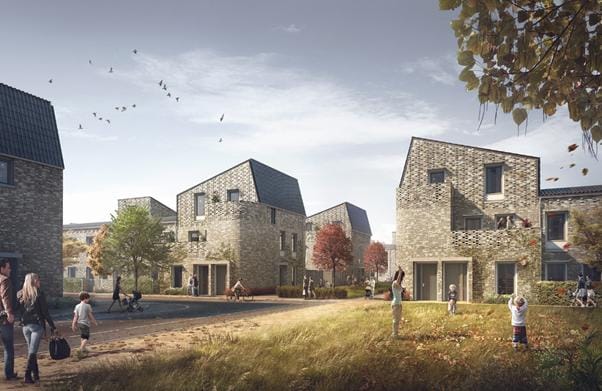There is a gaping hole in Irish housing provision for Council direct-builds, according to Úna Dunphy of People Before Profit. It’s out of kilter, not just with our own culture of housing provision, but with that of most other countries as well. Its loss has aided in the process of ever-increasing costs and out-pricing of homes across a constantly expanding cohort of the population. Huge amounts of public money go into the sausage machine of public housing but little, if any of it turns into bricks and mortar owned by Councils.
Rather than dwell on the political motivation, which is overwhelmingly evident in this regressive move over decades, it can be useful to look elsewhere to examples of other projects which, although not perfect, still manage to deliver in a progressive way, and at least include this traditional means of housing a population without wasting huge amounts of public money on middlemen.
“An example of this”, says Ms Dunphy, “is the Goldsmith Street in Norwich.
Norwich Council Housing Department have a 3 pronged approach:
● Negotiating with developers to provide affordable housing on private sites, in line with its planning policy
● Enabling developers and Housing Associations to deliver affordable housing on public land.
● Leading the Council’s own Build Programme.
We have very inflexible Councils, who are slow to utilise the tools available to react in a tangible way to the needs of the population for housing, and instead drip feed small projects through local developers with public money for public housing. Our expectations, especially in a ‘Housing Crisis’ are far too low for the money, or dare I say. ‘Value For Money’ in return for amounts paid”.
Norwich is a Medieval City. 19th Century Victorian terraces nearby had a strong influence on the design. Norwich City Council’s Goldsmith Street development become both the first energy-efficient Passive House project, and the first social housing project to win the Stirling Prize, British architecture’s most coveted award, with the judges calling it “high-quality architecture in its purest, most environmentally and socially conscious form”. It is 100% Council built and owned. It is not only environmentally sound as a passive house build, (fuel bills as low as €150 per year) but located in the City, which retains a population in an area where former trends towards the suburbs led to sprawl and more recently vacant buildings creating slums and requiring repurposing.
It is a plan that should be replicated by Irish Councils, especially in our Cities. Rethinking urban spaces needs to become a rolling agenda item across all committees, in order to avoid our Cities becoming run down and irrelevant to the communities who depend on them as centres for accommodation, civil services, education, employment and recreation. Shopping is part of it, but a smaller part, as are offices with the option of remote working. Councils lack creativity and reject innovative voices, to their detriment in most departments, but they do so to the neglect of their housing provision and to the relevance of urban spaces in a changing time.
In a Waterford context, where in the City centre is there Council owned land larger than the 3.1 acre site used in Norwich to provide 103 homes?
Remember that 5.1 acre site that was going to be gifted to the Saudis with empty pockets, anyone?
